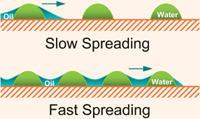An unexpected discovery into the way oil can spread across a surface holds numerous potential applications, report US researchers.
An unexpected discovery into the way oil can spread across a surface holds numerous potential applications, report US researchers.
Manoj Chaudhury and Ankur Chaudhury from Lehigh University found that hexadecane oil spreads much faster on a polystyrene surface that is partially covered with tiny water droplets than it does on the pure substrate. This observation is surprising said the researchers, as from a surface energy point of view there is no greater intrinsic driving force for spreading on the droplet-covered surface.

Chaudhury and Chaudhury have proposed a simple model to explain the observation. If there are few water droplets on the surface - ie the droplets are far apart - the oil has to reach from one droplet to the other with a very low dynamic contact angle. This makes the spreading very slow.
When the water droplets are closely spaced, oil moves faster from one drop to the next by maintaining a high dynamic contact angle. Oil nucleates under each drop and the spreading process is re-initiated from each drop to the next with non-zero dynamic angle. In this way, fast travel from one end of the surface to the other is possible.
Manoj Chaudhury likens the process to ’an approximate 2D version of liquid invasion through porous media’. He is excited about practical uses of the work, pointing out that enhancing the spreading rates could have applications in some situations where surfactants cannot be used. ’This phenomenon may also be utilised to produce thin films of controllable thickness and diameter,’ he said.
Philip Earis
References
M K Chaudhury and A Chaudhury, Soft Matter, 2005, 1, 431 (DOI: 10.1039/<MAN>b512045b</MAN>)






No comments yet